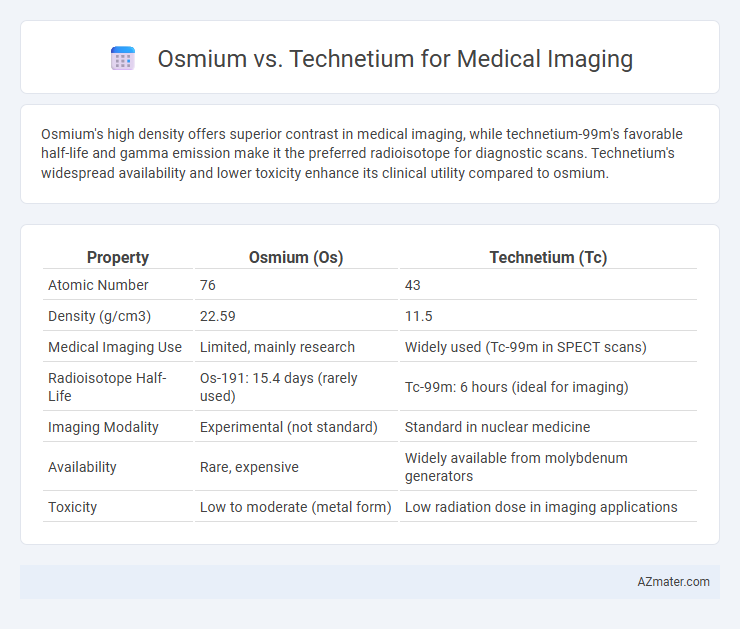Osmium's high density offers superior contrast in medical imaging, while technetium-99m's favorable half-life and gamma emission make it the preferred radioisotope for diagnostic scans. Technetium's widespread availability and lower toxicity enhance its clinical utility compared to osmium.
Table of Comparison
| Property | Osmium (Os) | Technetium (Tc) |
|---|---|---|
| Atomic Number | 76 | 43 |
| Density (g/cm3) | 22.59 | 11.5 |
| Medical Imaging Use | Limited, mainly research | Widely used (Tc-99m in SPECT scans) |
| Radioisotope Half-Life | Os-191: 15.4 days (rarely used) | Tc-99m: 6 hours (ideal for imaging) |
| Imaging Modality | Experimental (not standard) | Standard in nuclear medicine |
| Availability | Rare, expensive | Widely available from molybdenum generators |
| Toxicity | Low to moderate (metal form) | Low radiation dose in imaging applications |
Introduction to Osmium and Technetium in Medical Imaging
Osmium and Technetium are transition metals with distinct roles in medical imaging, where Technetium-99m is the most widely used radioisotope due to its ideal half-life of 6 hours and gamma-ray emission suitable for single-photon emission computed tomography (SPECT). Osmium, rarely used in imaging, offers high density and unique chemical properties, but lacks the widespread radiopharmaceutical development seen with Technetium. Technetium's versatility in labeling a variety of compounds supports diverse diagnostic applications including cardiac, bone, and brain scans, making it the cornerstone of nuclear medicine imaging.
Chemical Properties Relevant to Imaging Applications
Osmium and technetium differ significantly in chemical properties impacting their use in medical imaging; technetium, particularly technetium-99m, is favored due to its optimal gamma emission and relatively short half-life of 6 hours, allowing effective imaging with minimal radiation exposure. Osmium's high atomic number and density provide strong X-ray attenuation but its longer half-life isotopes and limited availability reduce its practicality compared to technetium in diagnostic scans. The chemical versatility of technetium enables the formation of stable complexes with diverse ligands, enhancing its specificity and effectiveness in nuclear medicine imaging agents.
Mechanisms of Action in Radiopharmaceuticals
Osmium and technetium differ significantly in their mechanisms of action in radiopharmaceuticals for medical imaging, with technetium-99m widely used due to its favorable gamma emission and short half-life of approximately 6 hours, allowing high-quality diagnostic images with minimal radiation exposure. Osmium isotopes, less commonly utilized, primarily offer potential in targeted alpha therapy rather than conventional imaging, leveraging heavy metal properties for localized radiotoxic effects. Technetium's ability to form complexes with various ligands enables precise organ-specific uptake, enhancing its role in single-photon emission computed tomography (SPECT) imaging compared to osmium's emerging applications in therapeutic radiopharmaceuticals.
Imaging Modalities Utilizing Osmium
Osmium's high atomic number and density make it suitable for enhancing contrast in imaging modalities such as X-ray computed tomography (CT) and electron microscopy, where it serves as a stain to improve visualization of cellular structures. Unlike technetium-99m, widely used in nuclear medicine for its ideal gamma emission and short half-life facilitating functional imaging, osmium primarily contributes to structural imaging by providing superior resolution and contrast at the microscopic level. Research into osmium nanoparticles is ongoing to explore their potential in targeted contrast agents, leveraging osmium's stability and electron density for improved diagnostic imaging in oncology and neurology.
Technetium’s Dominance in Nuclear Medicine
Technetium-99m is the most widely used radioisotope in nuclear medicine due to its ideal half-life of six hours and gamma-ray emission suitable for imaging. Osmium isotopes have limited application in medical imaging because of unfavorable decay properties and lack of established radiopharmaceuticals. The versatility and established production infrastructure of Technetium compounds, such as sestamibi and tetrofosmin, secure its dominance in diagnostic procedures like single-photon emission computed tomography (SPECT).
Safety and Toxicity Profiles
Osmium and technetium exhibit distinct safety and toxicity profiles relevant to medical imaging, where technetium-99m is preferred due to its low radiation dose and short half-life of approximately 6 hours, minimizing patient exposure. Osmium isotopes, though less commonly used, pose higher toxicity risks due to their heavier atomic weight and longer biological retention, increasing potential cellular damage. Technetium's chelation with various ligands enhances its biocompatibility and rapid clearance, making it safer for diagnostic procedures compared to osmium compounds.
Efficiency and Resolution in Diagnostic Imaging
Osmium's high atomic number (76) enhances X-ray attenuation, improving image contrast and resolution in diagnostic imaging, making it highly efficient for detailed tissue visualization. Technetium-99m, with its optimal half-life of 6 hours and gamma emission, offers targeted radiotracer efficiency and precise imaging in nuclear medicine. While osmium's density benefits structural imaging, technetium's radiopharmaceutical properties provide superior functional imaging resolution and diagnostic accuracy.
Availability and Cost Considerations
Osmium is extremely rare and costly, limiting its practical use in medical imaging despite its unique properties. Technetium, particularly Technetium-99m, is widely available and cost-effective due to its production in nuclear reactors, making it the preferred choice for diagnostic imaging. The established supply chain and lower expense of Technetium enhance its accessibility in clinical applications compared to Osmium.
Future Prospects and Research Directions
Osmium and technetium present distinct advantages in medical imaging, with technetium-99m currently dominating due to its ideal half-life and gamma-ray emission suitable for SPECT scans. Emerging research explores osmium isotopes for potential use in high-resolution imaging and targeted radiotherapy, leveraging osmium's unique chemical properties and stability. Future prospects emphasize developing novel osmium-based radiopharmaceuticals and optimizing technetium's production methods to enhance diagnostic accuracy and therapeutic outcomes in nuclear medicine.
Conclusion: Osmium vs Technetium for Clinical Imaging
Osmium and Technetium differ significantly in their clinical imaging applications, with Technetium-99m being the preferred radionuclide due to its optimal half-life, gamma emission energy, and availability for single photon emission computed tomography (SPECT). Osmium isotopes lack the favorable radiochemical properties and widespread clinical data that Technetium-99m possesses, limiting their use in routine diagnostic imaging. The established safety profile and versatility of Technetium-99m continue to make it the gold standard for nuclear medicine procedures.

Infographic: Osmium vs Technetium for Medical Imaging
 azmater.com
azmater.com